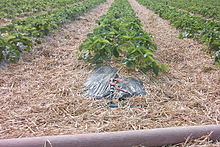Fertigation
Fertigation refers to the application of liquid or water-soluble fertilizers through an irrigation system. It is an artificial word from the English words fertilization (fertilization) and irrigation (irrigation)
For the farmer, fertilization using fertigation has the advantage that nutrients can be applied regardless of the weather and precisely tailored to the vegetation stage. In this way, significantly better growth and thus higher yields can be achieved.
As a rule, a drip irrigation system or mini-sprinklers (spaghetti system) are used for finishing. The irrigation system must be cleaned regularly, as the fertilizer in the irrigation water leads to deposits.
There are essentially two types of fertigation:
In the first type, which is mainly used for growing fruit and vegetables outdoors, the amount of fertilizer intended for the plants during a growth phase is divided by the number of planned applications and then applied weekly or half-weekly. The irrigation system must be completely filled with water before the fertilizer is fed in to ensure an even distribution of the fertilizer solution in the system. After the fertilization, intensive rinsing must be carried out. This fertigation technique works without expensive measurement and control technology and is easy to implement.
The second type of fertigation is usually used in substrate cultivation (fruit, vegetables, ornamental plants). In substrate cultivation, watering several times a day is necessary due to the small amount of substrate (or because hydroponics are used). A fertilizer stock solution tailored to the culture and the vegetation stage (see hydroponic fertilizers ) is constantly added to the irrigation water. The amount or concentration of the added fertilizer is determined by means of the EC value. The measurement of the irrigation water parameters is of great importance in this type of production, so the EC value must be optimally matched in order to prevent over- or under-supply or salinization of the substrate. In addition, the amount of irrigation water must be adjusted to the daytime weather and the morphology of the plants (other concentrations are better for flowering or fruit ripening than during the shoot growth).
Individual evidence
- ^ University of Wisconsin - Madison: Crop Protection Handbook . Meister Publishing Company, 2004, p. 13 .

